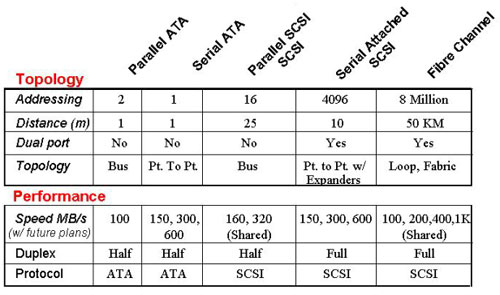Protocol Analysis
SAS Test and Verification: Teledyne LeCroy's new SASTracer is the first protocol analyzer designed from the ground up to address these unique characteristics of SAS including wide-links and Serial ATA interoperability. Based on Teledyne LeCroy's modular UPAS chassis, SASTracer includes a single plugin for monitoring 2 Wide links; and its expandable by adding a second plugin to monitor "4-wide" links. It displays multilane traffic interleaved and synchronized to a common reference clock. It also preserves the logical relationship between SSP initiators and targets by automatically grouping all frames that are part of a common transaction.
Serial ATA interoperability with SAS backplanes provides unprecedented flexibility for system designers in the storage arena. SAS and SATA will coexist side by side - possibly within the same storage enclosure. The ability to test and verify both protocols with a single instrument will become a necessity. In addition to STP support, the SASTracer has been designed with plug and play compatibility for pure SATA (1.5 and 3Gbps) protocol traffic. SASTracer will include a SATA software option that allows pure Serial ATA traffic to be recorded and verified using Teledyne LeCroy's Serial ATA analyzer software.
Teledyne LeCroy's expertise with high performance serial technologies has rewarded the industry with a modular chassis that can accommodate link rates of up to 12Gbps. This provides a highly portable platform for Serial Attached Storage analysis that is expandable for the higher bandwidth applications in the future. As the industry's first bi-lingual analyzer, SASTracer is clearly the most cost effective solution for validating SAS and SATA product designs.
SAS (Serial Attached SCSI) Overview
Serial Attached SCSI (SAS) is the next evolution of SCSI beyond Ultra320. It utilizes serial, point-to-point, switched architecture and promises to greatly expand upon the existing capabilities of its parallel predecessor. Serial Attached SCSI intends to leverage the 20 years of proven SCSI legacy middleware/software that is entrenched in the enterprise, as well as deliver a powerful small form factor connection scheme, capable of achieving substantially better performance and scalability than parallel SCSI offers today.
Table 1. Disk Drive Interface Comparison

Features
High Availability: As with SATA, Serial Attached SCSI is a high-speed, point-to-point technology initially designed to operate at speeds up to 3Gb/sec. System designers have found that point-to-point serial connections are inherently more reliable than shared bandwidth parallel connections. As a result, point-to-point serial connections have become the preferred method for implementing high-availability systems. Serial Attached SCSI will add dual-ported connections on to SAS based disk drives. This is a key requirement of high-availability SANs that call for redundant paths to all devices in the system.
Introducing SCSI Expanders: Serial Attached SCSI takes advantage of these VLSI advances to enable a highly scalable connection scheme and to allow the connection topology to grow through the use of "expanders." Expanders provide the necessary fan-out to create large enterprise-worthy configurations while maintaining legacy compatibility with SCSI software. SCSI Management protocol (SMP) is used to manage expanders. It establishes PHY control, configures route information, and performs discovery and link negotiation for individual SAS connections.
An important characteristic of Expanders is their ability to aggregate bandwidth by combining multiple physical links into a "Wide" port. These wide ports can function as intelligent switches and can independently send commands across one physical path with data being returned over a different physical path. This increases the complexity of SAS test and debug because it requires users to monitor multiple links concurrently to record all dwords associated with a single SCSI transaction.
SATA Compatibility: One of the most revolutionary of all the additions being offered by Serial Attached SCSI is the announcement that the SAS connector will be form-factor compatible with SATA. SATA drives will plug directly into Serial Attached SCSI connectors and if supported in the system, will transparently operate as SATA device. This allows systems to be deployed that can use either Serial Attached SCSI drives, for their high performance and high availability characteristics, or SATA drives that will provide a lower-cost-per-megabyte storage platform.
Links